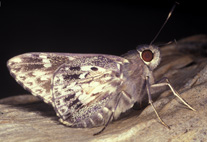Abstract
Partial life histories for 12 Hesperiinae incertae sedis that feed on palms (Arecaceae) are described and illustrated. The genera dealt with are: Perrotia (part), Ploetzia, Zophopetes, Gretna (part), Pteroteinon, Leona, and Caenides (part) (all from Evans’ Ploetzia genera group). Although Gamia spp. have been reported to feed on palms, these records are considered to be in error, as caterpillars of this genus feed on Dracaena spp. (Asparagaceae). The life histories of the species documented are fairly uniform, in that caterpillars of most species have rounded brown heads, wider basally, with or without limited black markings, smooth bodies and make simple shelters by rolling leaves. Variation in caterpillar markings and male genitalia of Zophopetes dysmephila (Trimen) and caterpillar and adult markings of Gretna carmen Evans merit further study. In G. carmen, G. waga (Plötz) and G. balenge (Holland), the caterpillars’ head and body are covered with hair-like setae, and develop an extensive covering of white waxy powder, which in G. balenge also covers the long setae. Furthermore, the pupa of G. balenge is unusual in having a pair of large, elaborate processes frontally on the head; when disturbed, the pupa vibrates violently and rattles noisily against the sides of the shelter. Ploetzia amygdalis (Mabille) and Pteroteinon laufella (Hewitson) have gregarious caterpillars, whereas the remaining species are solitary. After eclosion, the first instar caterpillars of Gretna spp. moult to the second instar without feeding. The implications of a palm-feeding life-style are discussed, and economic damage and plant quarantine risks to coconut, oil palm and ornamental palms pointed out. The known life histories suggest that all Afrotropical palm-feeding Hesperiidae will belong in the same tribe when the incertae sedis section is further elucidated, although the affinities of Gretna deserve further consideration.

